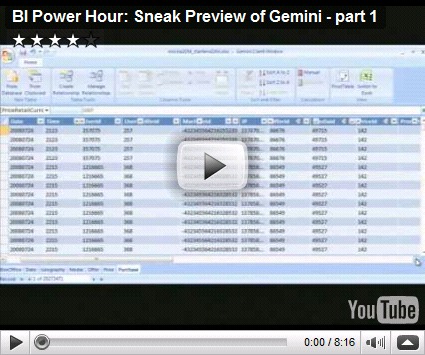Self Service BI in Retail
I've been in several meetings with retailers where business users and IT have been at odds with each other over business intelligence and reporting. At many of the retailers, I have noticed that business groups tend to own a large part of the Business Intelligence Applications and IT has very little control over it. A healthy balance is when IT has governance and control over the environment and at the same time, the business groups have the ability to generate their own content and reporting. This is where managed self service BI comes in.
SQL Server 2008 R2 is the next generation of the Microsoft SQL Server database platform, planned for release in the first half of calendar year 2010. Self-Service BI is one of the capabilities in the new release. SQL Server 2008 R2 provides both end-users and IT with powerful tools to create, analyze and model, share and manage business intelligence data in a secure and streamlined way.
Self-service analysis tools allow end-users to quickly create solutions from disparate data sources within a familiar Microsoft Office Excel user interface. By publishing these solutions in SharePoint Server, users can easily share them with others. IT gains management and oversight so they can help ensure the reliability, performance, and security of data-driven assets across the enterprise while also gaining better visibility into how people are using their data.
These new tools will empower retailers to extend the benefits of BI across the company with minimal dependence on IT to help drive smarter, quicker decision-making, free up IT staff for more valuable activities, and dramatically drive down deployment costs.
The merchandizing planners pull together budget for the year based on data from the previous year or season. They can access the historic data from their reporting databases but are often challenged with analyzing the data against trends and demographic information obtained from third party sources(possibly in an Excel Spreadsheet). Using traditional BI systems, this can be a challenge that requires the merchandizing planners to work with IT to help integrate the third party data into the reporting system. With Project Gemini, the merchandizing Planners are empowered with self-service analysis capabilities. The in-memory BI capabilities deployed as an add-in for Excel enables merchandizing managers to quickly analyze data and gain new insights into customer behavior and trends.
In the merchandize planning process, buyers, category and department managers need to make decisions and plans around what merchandize to sell at what store on a week by week basis. At the same time they also have to meet the target set in the budget. Events, Promotions and other external factors have an impact on these decisions and they need additional data to help get better insights during this process. Self-service analytical applications can empower people to make quicker and better decisions without having to involve IT. Excel Data-Mining Add ins enable users to access the powerful analytics engine from SQL Server to quickly analyze information to assist in pricing, allocation of inventory to stores and space allotted to each item in each stores display.
Retailers can benefit in streamlining and improving the demand planning processes around campaigns, promotions, reconciling the demand forecast, including seasonal and regional variations, product introductions and retirements, and planned promotional activity with the supply plan using self-service BI.
Microsoft’s BI solution spans Microsoft Office Excel and other Office applications for individual BI, Microsoft Office SharePoint Server for team BI and Microsoft Office PerformancePoint Server for organizationwide BI, with SQL Server as the data platform. This seamlessly interoperable, end-to-end lineup uniquely positions the retailer to deliver on the promise of ubiquitous BI by offering organizations compelling benefits designed to include these:
- Lower TCO. Ability to utilize existing investments in SQL Server, SharePoint and Office and drive end-user adoption to dramatically bring down per-user costs and generate unprecedented economies
- Rapid deployment and faster time-to-benefits. Easy onramp to powerful BI capabilities embedded within the everyday productivity tools employees already use, promoting wide end-user adoption
- Freeing up IT to act as a true strategic differentiator. Empowering information workers to quickly access information and perform their own analysis with minimal hand-holding from IT enables IT staff to concentrate their efforts where they can have the most strategic value for the business.
- Powerful synergies with other Microsoft applications. Ability to deploy the unified communications capabilities within Office Communications Server, for example, to nimbly act on BI-generated insights and “spread the wealth” with co-workers, customers, partners and suppliers
![R2_SSBI[1] R2_SSBI[1]](https://msdntnarchive.z22.web.core.windows.net/media/TNBlogsFS/BlogFileStorage/blogs_msdn/shishirs/WindowsLiveWriter/SelfServiceBIinRetail_C732/R2_SSBI%5B1%5D_3.jpg)

